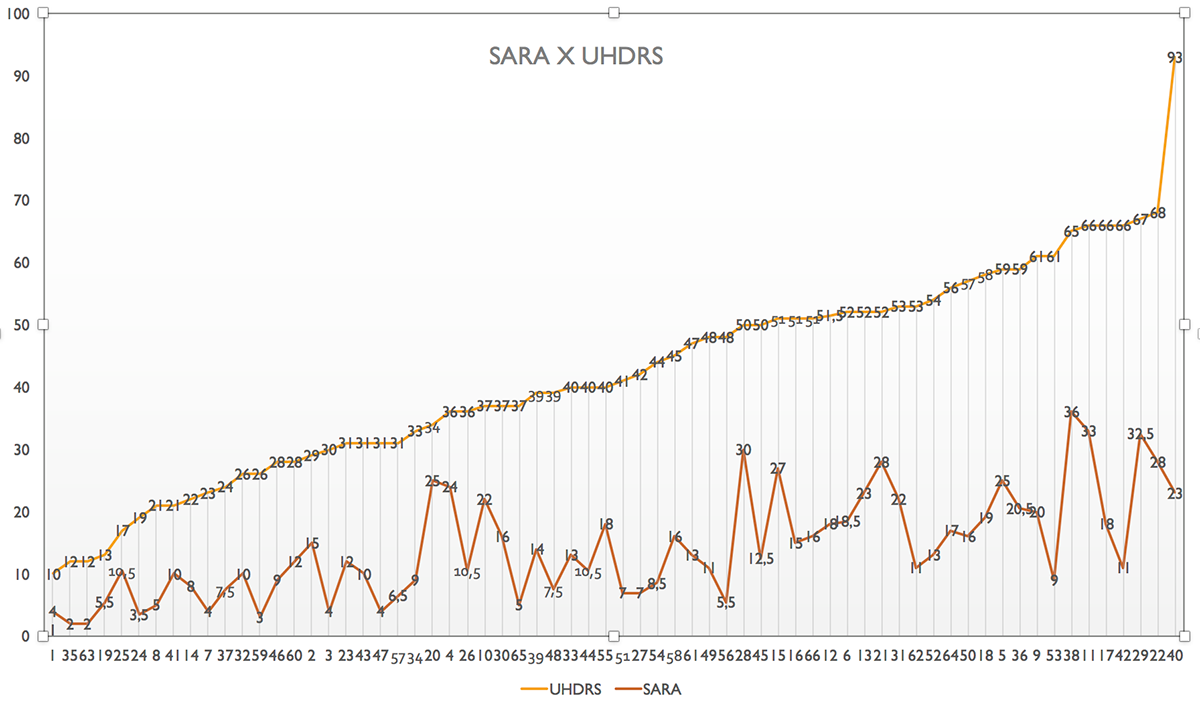Session Information
Date: Monday, September 23, 2019
Session Title: Huntington’s Disease
Session Time: 1:45pm-3:15pm
Location: Agora 3 West, Level 3
Objective: To analyze the prevalence of cerebellar ataxia in patients with Huntington’s Disease (HD), both early and late on HD progression and correlating the degree of ataxia with other symptoms traditionally associated with HD.
Background: HD is a hereditary neurodegenerative disorder characterized by progressive motor, cognitive and psychiatric changes. Motor symptoms are most commonly expressed as chorea and, less commonly, as parkinsonism, myoclonus and ataxia. Non-choreic symptoms such as ataxia are regarded as rare.
Method: We performed a multicentric cross-sectional study, in which we evaluated 124 patients with a genetically diagnosis of HD in 4 movement disorders centers in Brazil. Patients with advanced dementia, physical limitations that prevented proper examination or asymptomatic patients were excluded. Thus, 71 patients were eligible for the study. Classic scales used for assessing ataxia, SARA (Scale for Assessment and Rating of Ataxia) and BARS (Brief Ataxia Rating Scale), were applied in all patients, in addition to the Unified Huntington’s Disease Rating Scale (UHDRS).
Results: Of the 71 eligible patients, 41 patients had initial presentation of chorea, 12 of psychiatric disorder, 6 presented as ataxia, 3 with cognitive symptoms, 1 with parkinsonism, 1 with tics and 7 was undetermined. The mean time of disease was 9.75 years. The disease duration ranged from 1.5 to 20 years. 67 patients had more than 3.5 points on SARA scale, representing 94% of the patients. 25% of the patients evaluated had 10 points or higher on the SARA scale, despite having 40 points or less on the UHDRS scale. The genetic expansion CAG ranged from 39 to 47, and was not correlated to the symptom of ataxia.
Conclusion: The prevalence of cerebellar ataxia in Huntington’s Disease seems to be much higher than showed in the literature, so that it seems to be present in virtually all patients with HD, and it is an early event during the pathological process of HD, so that ataxia can be seen as first symptom. Chorea and other classic signs of HD assessed by UHDRS do not progress proportionally to the symptoms of cerebellar ataxia assessed by SARA and BARS, suggesting that the damage to the cerebellum does not develop simultaneously with, but independently, from the well-known classical lesions in the striatum.
References: 1. Becker N, Munhoz RP, Raskin S, Werneck LC, Teive HA. Non-choreic movement disorders as initial manifestations of Huntington’s disease. Arq Neuropsiquiatr. 2007 Jun;65(2B):402-5 2. Squitieri F, Berardelli A, Nargi E, Castellotti B, Mariotti C, Cannella M, Lavitrano ML, de Grazia U, Gellera C, Ruggieri S. Atypical movement disorders in the early stages of Huntington’s disease: clinical and genetic analysis. Clin Genet. 2000 Jul;58(1):50-6 3. Rodda, R.A. Cerebellar atrophy in Huntington’s disease. Journal of the Neurological Sciences. 1981 4. Rodríguez-quiroga S. A et al. Huntington’s disease masquerading as spinocerebellar ataxia. BMJ Case Reports. 2013. 5. Rüb U et al. Degeneration of the Cerebellum in Huntington’s Disease (HD): Possible Relevance for the Clinical Picture and Potential Gateway to Pathological Mechanisms of the Disease Process. Brain Pathology (2013) 165–177
To cite this abstract in AMA style:
GLF. Franklin, HAT. Teive, FBG. Germiniani, SR. Raskin, GMP. Pavanelli, SSM. Milano, NSL. Lima, OPB. Barsottini, JLP. Pedroso, FAM. Maggi, VT. Tumas, PMC. Carvalho, PCA. Azevedo, ILC. Lopes-Cendes. Cerebellar Ataxia in Patients with Huntington’s Disease, an underestimated symptom? [abstract]. Mov Disord. 2019; 34 (suppl 2). https://www.mdsabstracts.org/abstract/cerebellar-ataxia-in-patients-with-huntingtons-disease-an-underestimated-symptom/. Accessed December 11, 2025.« Back to 2019 International Congress
MDS Abstracts - https://www.mdsabstracts.org/abstract/cerebellar-ataxia-in-patients-with-huntingtons-disease-an-underestimated-symptom/

